Food Policies in Healthcare Assignment 2022
VerifiedAdded on 2022/10/19
|7
|1565
|7
Assignment
AI Summary
Contribute Materials
Your contribution can guide someone’s learning journey. Share your
documents today.
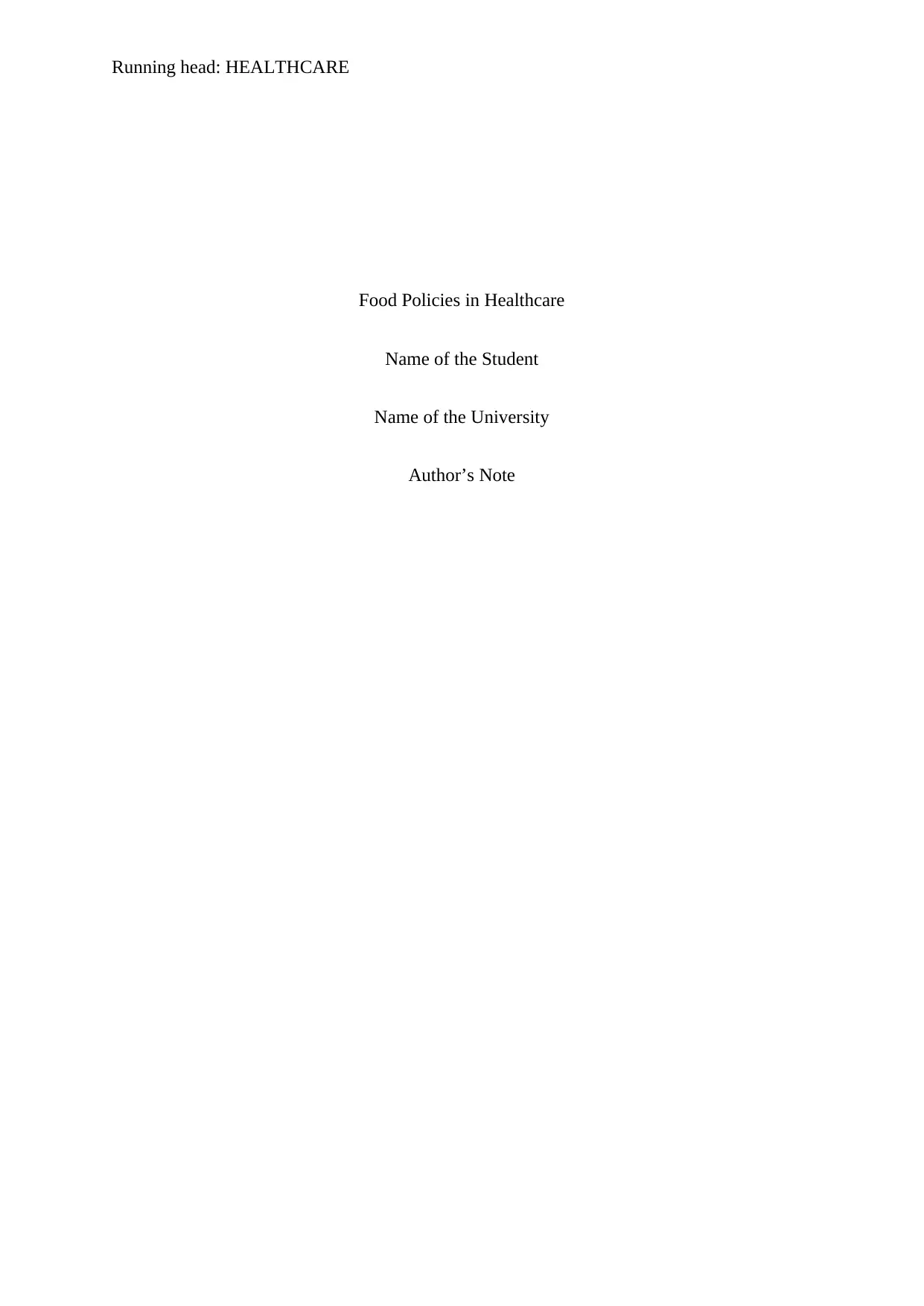
Running head: HEALTHCARE
Food Policies in Healthcare
Name of the Student
Name of the University
Author’s Note
Food Policies in Healthcare
Name of the Student
Name of the University
Author’s Note
Secure Best Marks with AI Grader
Need help grading? Try our AI Grader for instant feedback on your assignments.
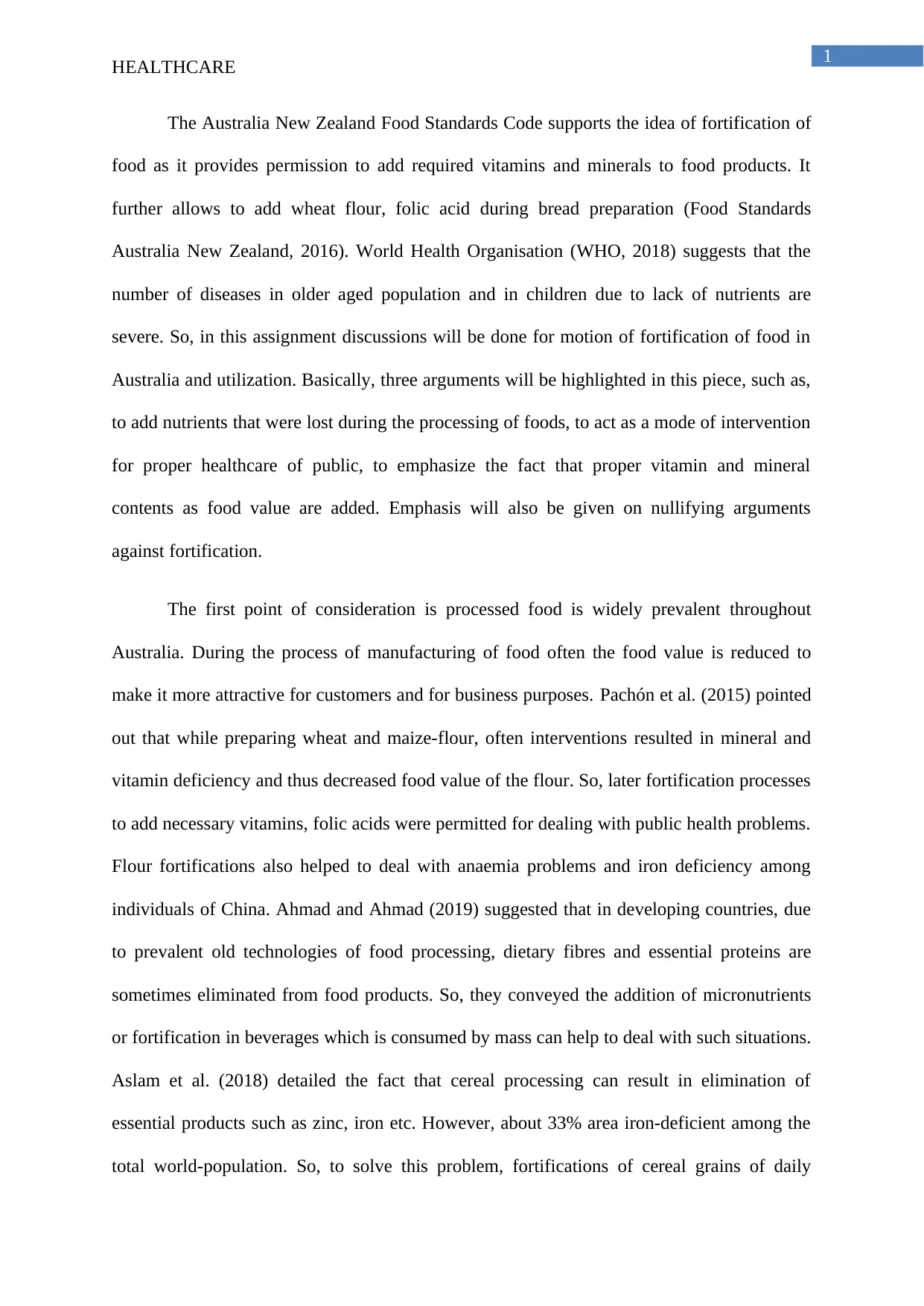
1
HEALTHCARE
The Australia New Zealand Food Standards Code supports the idea of fortification of
food as it provides permission to add required vitamins and minerals to food products. It
further allows to add wheat flour, folic acid during bread preparation (Food Standards
Australia New Zealand, 2016). World Health Organisation (WHO, 2018) suggests that the
number of diseases in older aged population and in children due to lack of nutrients are
severe. So, in this assignment discussions will be done for motion of fortification of food in
Australia and utilization. Basically, three arguments will be highlighted in this piece, such as,
to add nutrients that were lost during the processing of foods, to act as a mode of intervention
for proper healthcare of public, to emphasize the fact that proper vitamin and mineral
contents as food value are added. Emphasis will also be given on nullifying arguments
against fortification.
The first point of consideration is processed food is widely prevalent throughout
Australia. During the process of manufacturing of food often the food value is reduced to
make it more attractive for customers and for business purposes. Pachón et al. (2015) pointed
out that while preparing wheat and maize-flour, often interventions resulted in mineral and
vitamin deficiency and thus decreased food value of the flour. So, later fortification processes
to add necessary vitamins, folic acids were permitted for dealing with public health problems.
Flour fortifications also helped to deal with anaemia problems and iron deficiency among
individuals of China. Ahmad and Ahmad (2019) suggested that in developing countries, due
to prevalent old technologies of food processing, dietary fibres and essential proteins are
sometimes eliminated from food products. So, they conveyed the addition of micronutrients
or fortification in beverages which is consumed by mass can help to deal with such situations.
Aslam et al. (2018) detailed the fact that cereal processing can result in elimination of
essential products such as zinc, iron etc. However, about 33% area iron-deficient among the
total world-population. So, to solve this problem, fortifications of cereal grains of daily
HEALTHCARE
The Australia New Zealand Food Standards Code supports the idea of fortification of
food as it provides permission to add required vitamins and minerals to food products. It
further allows to add wheat flour, folic acid during bread preparation (Food Standards
Australia New Zealand, 2016). World Health Organisation (WHO, 2018) suggests that the
number of diseases in older aged population and in children due to lack of nutrients are
severe. So, in this assignment discussions will be done for motion of fortification of food in
Australia and utilization. Basically, three arguments will be highlighted in this piece, such as,
to add nutrients that were lost during the processing of foods, to act as a mode of intervention
for proper healthcare of public, to emphasize the fact that proper vitamin and mineral
contents as food value are added. Emphasis will also be given on nullifying arguments
against fortification.
The first point of consideration is processed food is widely prevalent throughout
Australia. During the process of manufacturing of food often the food value is reduced to
make it more attractive for customers and for business purposes. Pachón et al. (2015) pointed
out that while preparing wheat and maize-flour, often interventions resulted in mineral and
vitamin deficiency and thus decreased food value of the flour. So, later fortification processes
to add necessary vitamins, folic acids were permitted for dealing with public health problems.
Flour fortifications also helped to deal with anaemia problems and iron deficiency among
individuals of China. Ahmad and Ahmad (2019) suggested that in developing countries, due
to prevalent old technologies of food processing, dietary fibres and essential proteins are
sometimes eliminated from food products. So, they conveyed the addition of micronutrients
or fortification in beverages which is consumed by mass can help to deal with such situations.
Aslam et al. (2018) detailed the fact that cereal processing can result in elimination of
essential products such as zinc, iron etc. However, about 33% area iron-deficient among the
total world-population. So, to solve this problem, fortifications of cereal grains of daily
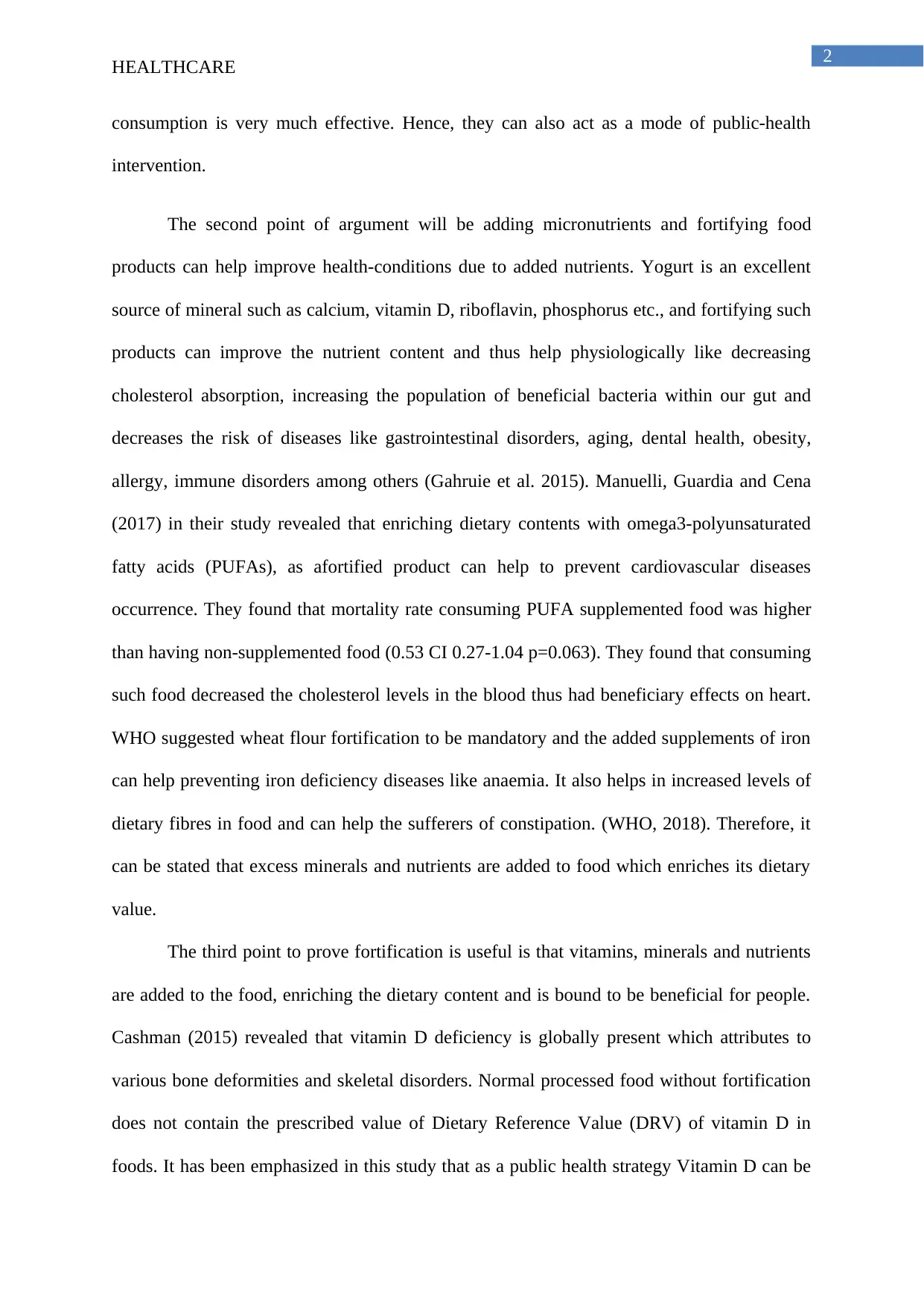
2
HEALTHCARE
consumption is very much effective. Hence, they can also act as a mode of public-health
intervention.
The second point of argument will be adding micronutrients and fortifying food
products can help improve health-conditions due to added nutrients. Yogurt is an excellent
source of mineral such as calcium, vitamin D, riboflavin, phosphorus etc., and fortifying such
products can improve the nutrient content and thus help physiologically like decreasing
cholesterol absorption, increasing the population of beneficial bacteria within our gut and
decreases the risk of diseases like gastrointestinal disorders, aging, dental health, obesity,
allergy, immune disorders among others (Gahruie et al. 2015). Manuelli, Guardia and Cena
(2017) in their study revealed that enriching dietary contents with omega3-polyunsaturated
fatty acids (PUFAs), as afortified product can help to prevent cardiovascular diseases
occurrence. They found that mortality rate consuming PUFA supplemented food was higher
than having non-supplemented food (0.53 CI 0.27-1.04 p=0.063). They found that consuming
such food decreased the cholesterol levels in the blood thus had beneficiary effects on heart.
WHO suggested wheat flour fortification to be mandatory and the added supplements of iron
can help preventing iron deficiency diseases like anaemia. It also helps in increased levels of
dietary fibres in food and can help the sufferers of constipation. (WHO, 2018). Therefore, it
can be stated that excess minerals and nutrients are added to food which enriches its dietary
value.
The third point to prove fortification is useful is that vitamins, minerals and nutrients
are added to the food, enriching the dietary content and is bound to be beneficial for people.
Cashman (2015) revealed that vitamin D deficiency is globally present which attributes to
various bone deformities and skeletal disorders. Normal processed food without fortification
does not contain the prescribed value of Dietary Reference Value (DRV) of vitamin D in
foods. It has been emphasized in this study that as a public health strategy Vitamin D can be
HEALTHCARE
consumption is very much effective. Hence, they can also act as a mode of public-health
intervention.
The second point of argument will be adding micronutrients and fortifying food
products can help improve health-conditions due to added nutrients. Yogurt is an excellent
source of mineral such as calcium, vitamin D, riboflavin, phosphorus etc., and fortifying such
products can improve the nutrient content and thus help physiologically like decreasing
cholesterol absorption, increasing the population of beneficial bacteria within our gut and
decreases the risk of diseases like gastrointestinal disorders, aging, dental health, obesity,
allergy, immune disorders among others (Gahruie et al. 2015). Manuelli, Guardia and Cena
(2017) in their study revealed that enriching dietary contents with omega3-polyunsaturated
fatty acids (PUFAs), as afortified product can help to prevent cardiovascular diseases
occurrence. They found that mortality rate consuming PUFA supplemented food was higher
than having non-supplemented food (0.53 CI 0.27-1.04 p=0.063). They found that consuming
such food decreased the cholesterol levels in the blood thus had beneficiary effects on heart.
WHO suggested wheat flour fortification to be mandatory and the added supplements of iron
can help preventing iron deficiency diseases like anaemia. It also helps in increased levels of
dietary fibres in food and can help the sufferers of constipation. (WHO, 2018). Therefore, it
can be stated that excess minerals and nutrients are added to food which enriches its dietary
value.
The third point to prove fortification is useful is that vitamins, minerals and nutrients
are added to the food, enriching the dietary content and is bound to be beneficial for people.
Cashman (2015) revealed that vitamin D deficiency is globally present which attributes to
various bone deformities and skeletal disorders. Normal processed food without fortification
does not contain the prescribed value of Dietary Reference Value (DRV) of vitamin D in
foods. It has been emphasized in this study that as a public health strategy Vitamin D can be
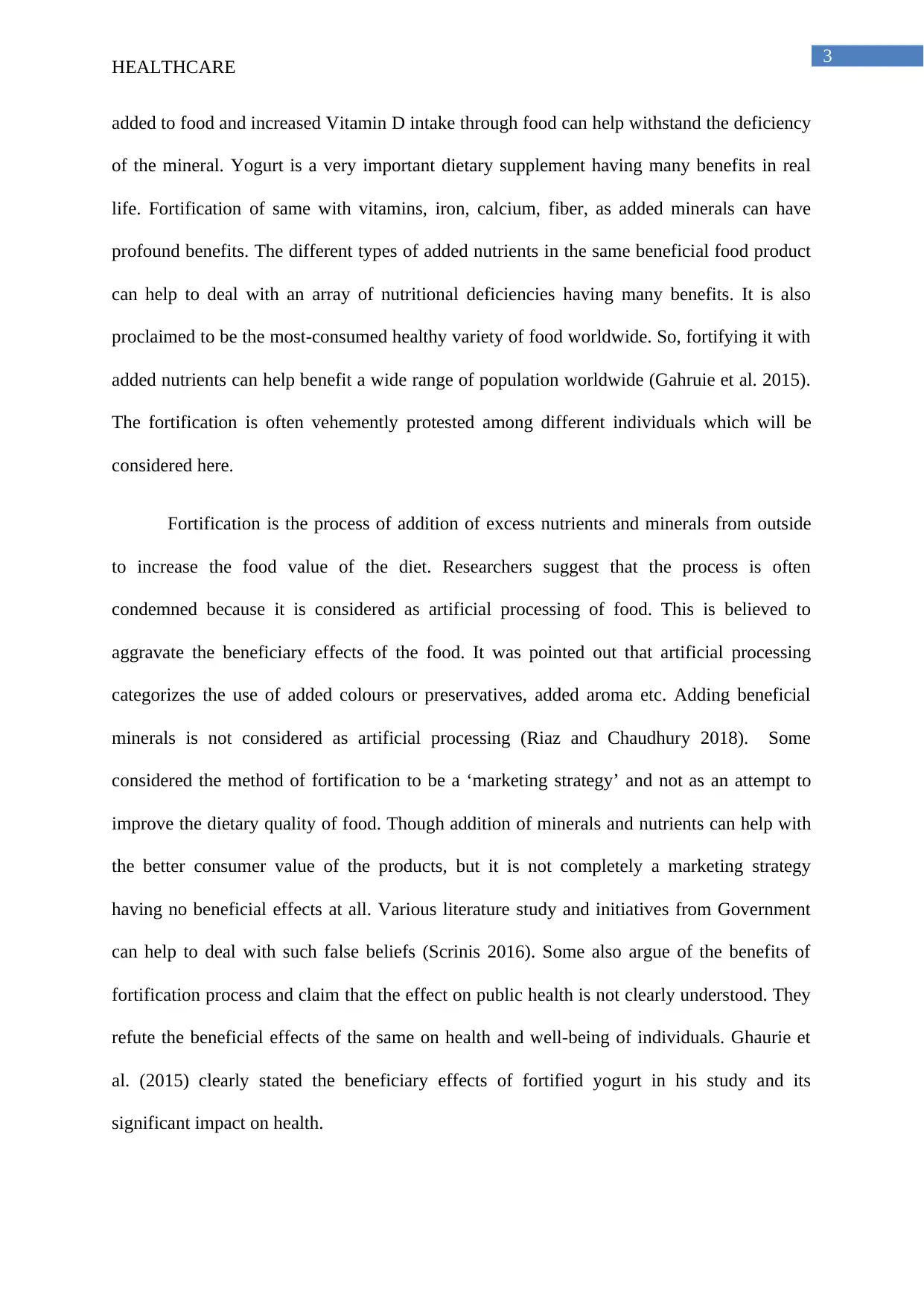
3
HEALTHCARE
added to food and increased Vitamin D intake through food can help withstand the deficiency
of the mineral. Yogurt is a very important dietary supplement having many benefits in real
life. Fortification of same with vitamins, iron, calcium, fiber, as added minerals can have
profound benefits. The different types of added nutrients in the same beneficial food product
can help to deal with an array of nutritional deficiencies having many benefits. It is also
proclaimed to be the most-consumed healthy variety of food worldwide. So, fortifying it with
added nutrients can help benefit a wide range of population worldwide (Gahruie et al. 2015).
The fortification is often vehemently protested among different individuals which will be
considered here.
Fortification is the process of addition of excess nutrients and minerals from outside
to increase the food value of the diet. Researchers suggest that the process is often
condemned because it is considered as artificial processing of food. This is believed to
aggravate the beneficiary effects of the food. It was pointed out that artificial processing
categorizes the use of added colours or preservatives, added aroma etc. Adding beneficial
minerals is not considered as artificial processing (Riaz and Chaudhury 2018). Some
considered the method of fortification to be a ‘marketing strategy’ and not as an attempt to
improve the dietary quality of food. Though addition of minerals and nutrients can help with
the better consumer value of the products, but it is not completely a marketing strategy
having no beneficial effects at all. Various literature study and initiatives from Government
can help to deal with such false beliefs (Scrinis 2016). Some also argue of the benefits of
fortification process and claim that the effect on public health is not clearly understood. They
refute the beneficial effects of the same on health and well-being of individuals. Ghaurie et
al. (2015) clearly stated the beneficiary effects of fortified yogurt in his study and its
significant impact on health.
HEALTHCARE
added to food and increased Vitamin D intake through food can help withstand the deficiency
of the mineral. Yogurt is a very important dietary supplement having many benefits in real
life. Fortification of same with vitamins, iron, calcium, fiber, as added minerals can have
profound benefits. The different types of added nutrients in the same beneficial food product
can help to deal with an array of nutritional deficiencies having many benefits. It is also
proclaimed to be the most-consumed healthy variety of food worldwide. So, fortifying it with
added nutrients can help benefit a wide range of population worldwide (Gahruie et al. 2015).
The fortification is often vehemently protested among different individuals which will be
considered here.
Fortification is the process of addition of excess nutrients and minerals from outside
to increase the food value of the diet. Researchers suggest that the process is often
condemned because it is considered as artificial processing of food. This is believed to
aggravate the beneficiary effects of the food. It was pointed out that artificial processing
categorizes the use of added colours or preservatives, added aroma etc. Adding beneficial
minerals is not considered as artificial processing (Riaz and Chaudhury 2018). Some
considered the method of fortification to be a ‘marketing strategy’ and not as an attempt to
improve the dietary quality of food. Though addition of minerals and nutrients can help with
the better consumer value of the products, but it is not completely a marketing strategy
having no beneficial effects at all. Various literature study and initiatives from Government
can help to deal with such false beliefs (Scrinis 2016). Some also argue of the benefits of
fortification process and claim that the effect on public health is not clearly understood. They
refute the beneficial effects of the same on health and well-being of individuals. Ghaurie et
al. (2015) clearly stated the beneficiary effects of fortified yogurt in his study and its
significant impact on health.
Secure Best Marks with AI Grader
Need help grading? Try our AI Grader for instant feedback on your assignments.
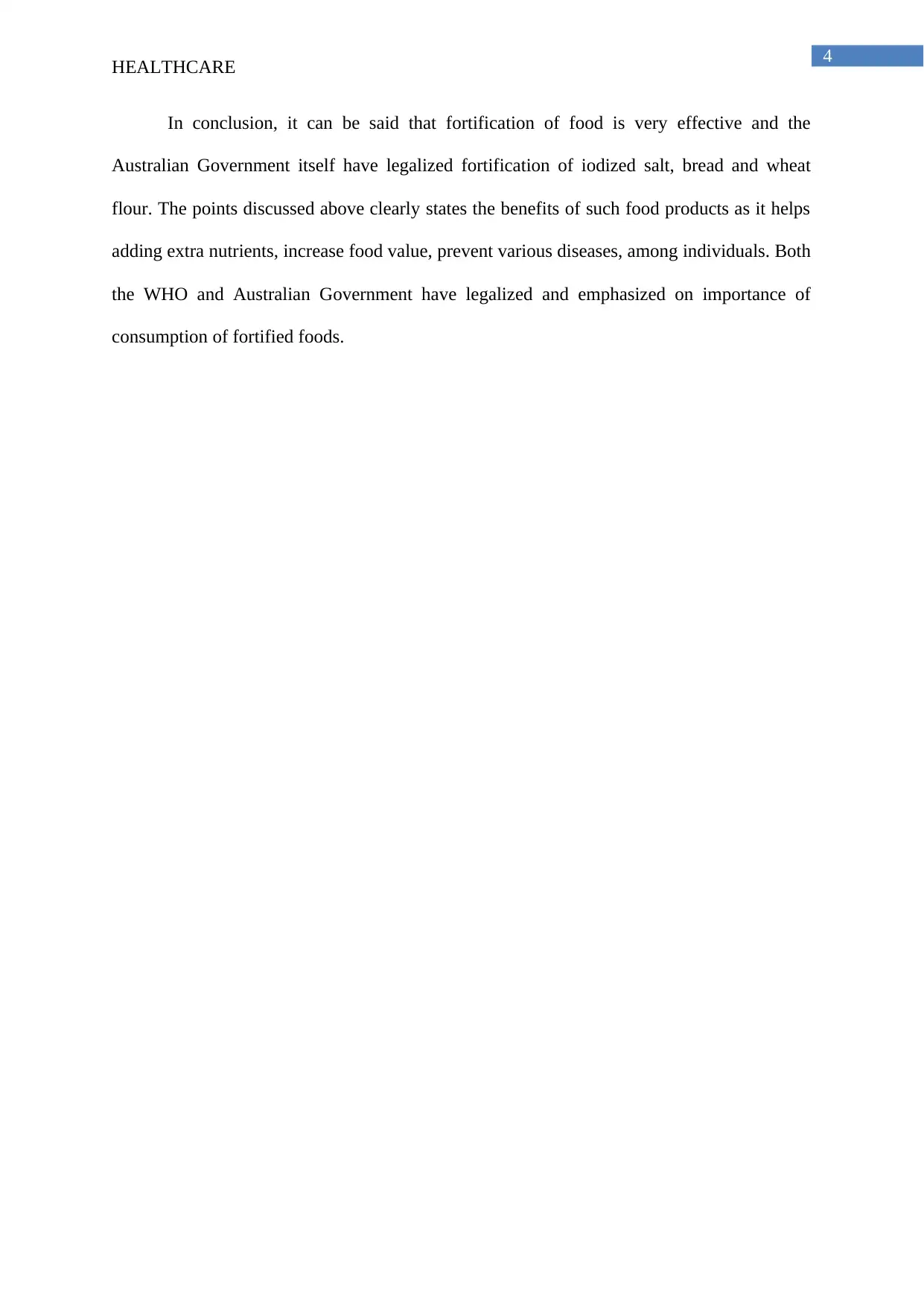
4
HEALTHCARE
In conclusion, it can be said that fortification of food is very effective and the
Australian Government itself have legalized fortification of iodized salt, bread and wheat
flour. The points discussed above clearly states the benefits of such food products as it helps
adding extra nutrients, increase food value, prevent various diseases, among individuals. Both
the WHO and Australian Government have legalized and emphasized on importance of
consumption of fortified foods.
HEALTHCARE
In conclusion, it can be said that fortification of food is very effective and the
Australian Government itself have legalized fortification of iodized salt, bread and wheat
flour. The points discussed above clearly states the benefits of such food products as it helps
adding extra nutrients, increase food value, prevent various diseases, among individuals. Both
the WHO and Australian Government have legalized and emphasized on importance of
consumption of fortified foods.
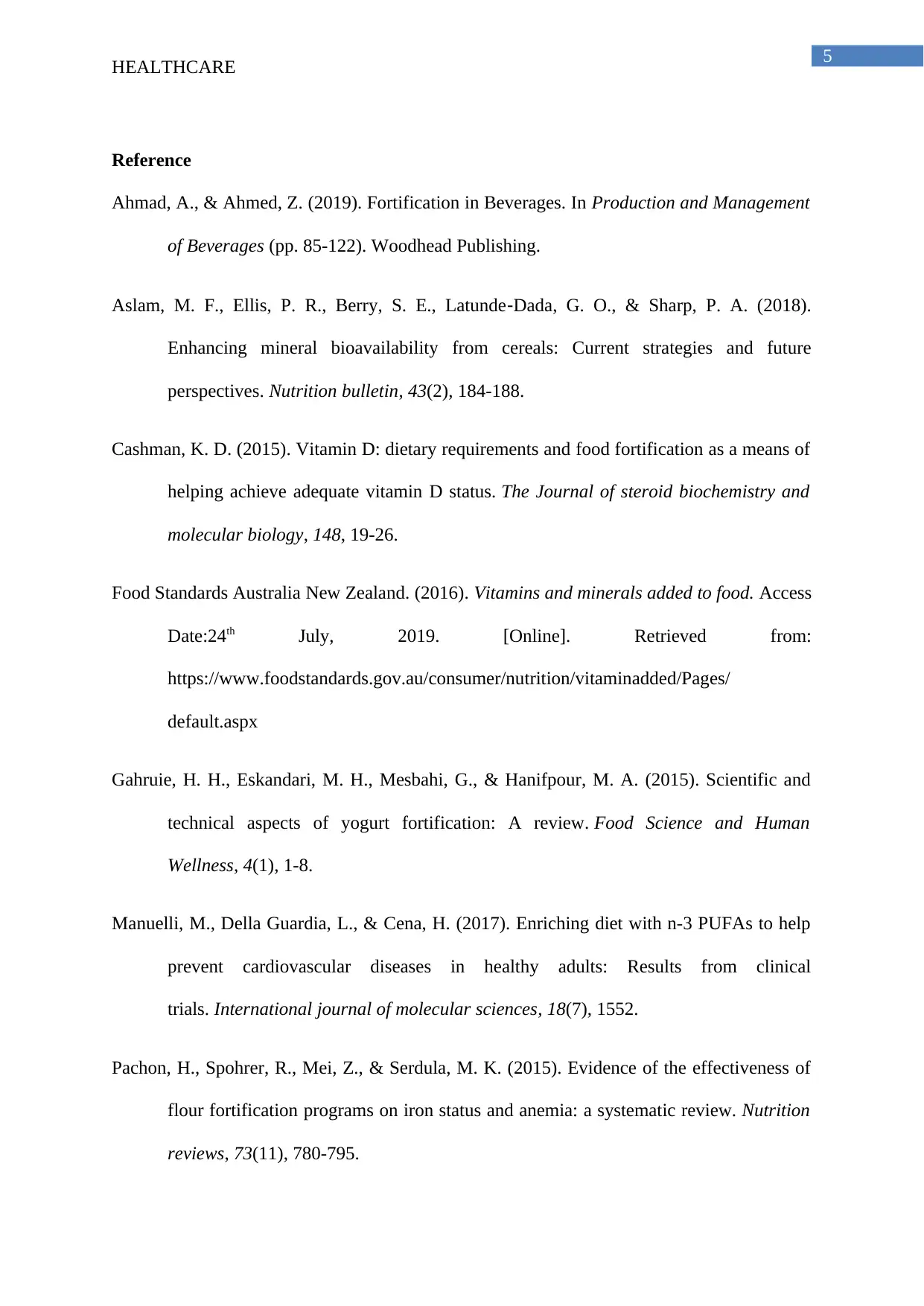
5
HEALTHCARE
Reference
Ahmad, A., & Ahmed, Z. (2019). Fortification in Beverages. In Production and Management
of Beverages (pp. 85-122). Woodhead Publishing.
Aslam, M. F., Ellis, P. R., Berry, S. E., Latunde‐Dada, G. O., & Sharp, P. A. (2018).
Enhancing mineral bioavailability from cereals: Current strategies and future
perspectives. Nutrition bulletin, 43(2), 184-188.
Cashman, K. D. (2015). Vitamin D: dietary requirements and food fortification as a means of
helping achieve adequate vitamin D status. The Journal of steroid biochemistry and
molecular biology, 148, 19-26.
Food Standards Australia New Zealand. (2016). Vitamins and minerals added to food. Access
Date:24th July, 2019. [Online]. Retrieved from:
https://www.foodstandards.gov.au/consumer/nutrition/vitaminadded/Pages/
default.aspx
Gahruie, H. H., Eskandari, M. H., Mesbahi, G., & Hanifpour, M. A. (2015). Scientific and
technical aspects of yogurt fortification: A review. Food Science and Human
Wellness, 4(1), 1-8.
Manuelli, M., Della Guardia, L., & Cena, H. (2017). Enriching diet with n-3 PUFAs to help
prevent cardiovascular diseases in healthy adults: Results from clinical
trials. International journal of molecular sciences, 18(7), 1552.
Pachon, H., Spohrer, R., Mei, Z., & Serdula, M. K. (2015). Evidence of the effectiveness of
flour fortification programs on iron status and anemia: a systematic review. Nutrition
reviews, 73(11), 780-795.
HEALTHCARE
Reference
Ahmad, A., & Ahmed, Z. (2019). Fortification in Beverages. In Production and Management
of Beverages (pp. 85-122). Woodhead Publishing.
Aslam, M. F., Ellis, P. R., Berry, S. E., Latunde‐Dada, G. O., & Sharp, P. A. (2018).
Enhancing mineral bioavailability from cereals: Current strategies and future
perspectives. Nutrition bulletin, 43(2), 184-188.
Cashman, K. D. (2015). Vitamin D: dietary requirements and food fortification as a means of
helping achieve adequate vitamin D status. The Journal of steroid biochemistry and
molecular biology, 148, 19-26.
Food Standards Australia New Zealand. (2016). Vitamins and minerals added to food. Access
Date:24th July, 2019. [Online]. Retrieved from:
https://www.foodstandards.gov.au/consumer/nutrition/vitaminadded/Pages/
default.aspx
Gahruie, H. H., Eskandari, M. H., Mesbahi, G., & Hanifpour, M. A. (2015). Scientific and
technical aspects of yogurt fortification: A review. Food Science and Human
Wellness, 4(1), 1-8.
Manuelli, M., Della Guardia, L., & Cena, H. (2017). Enriching diet with n-3 PUFAs to help
prevent cardiovascular diseases in healthy adults: Results from clinical
trials. International journal of molecular sciences, 18(7), 1552.
Pachon, H., Spohrer, R., Mei, Z., & Serdula, M. K. (2015). Evidence of the effectiveness of
flour fortification programs on iron status and anemia: a systematic review. Nutrition
reviews, 73(11), 780-795.
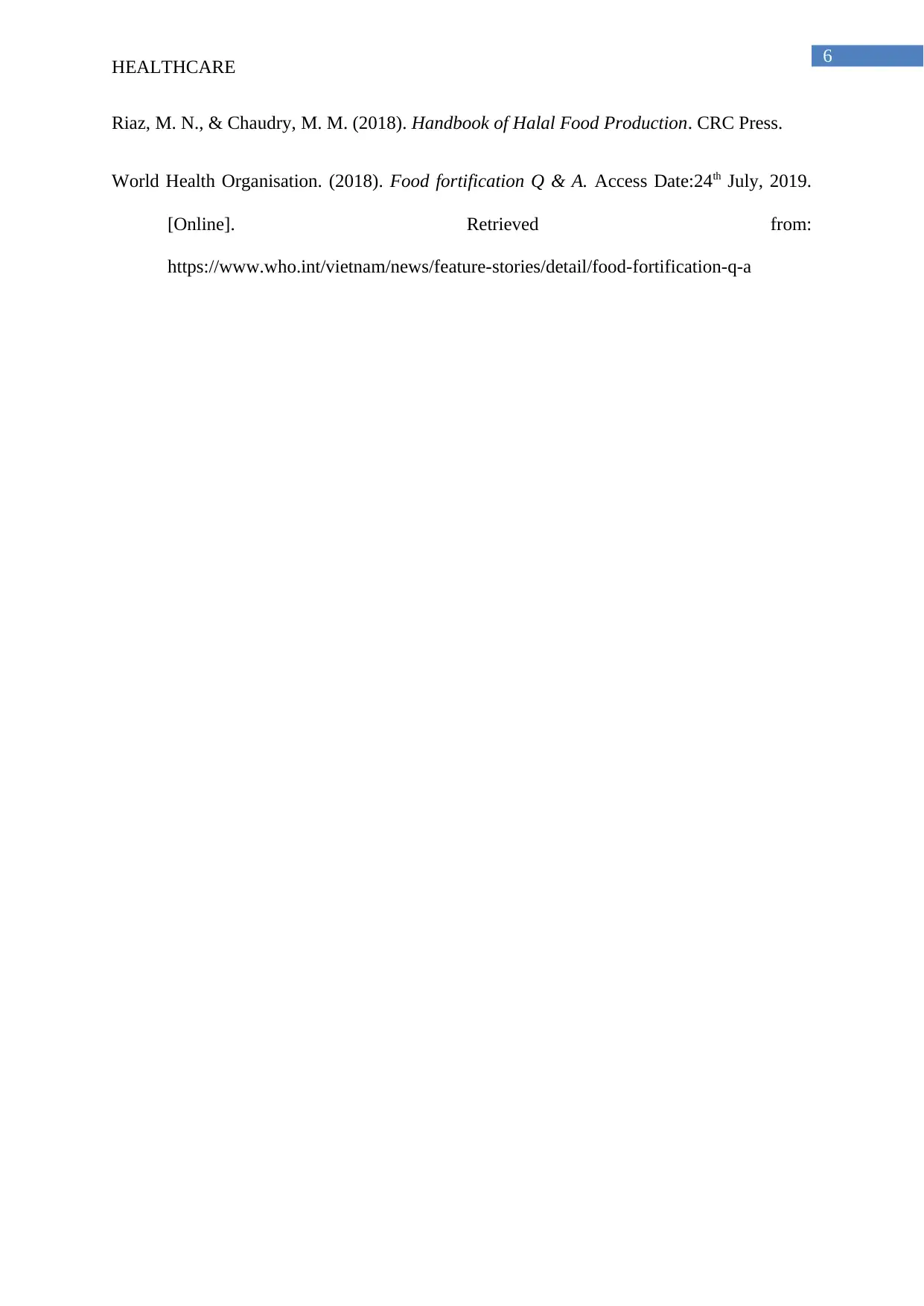
6
HEALTHCARE
Riaz, M. N., & Chaudry, M. M. (2018). Handbook of Halal Food Production. CRC Press.
World Health Organisation. (2018). Food fortification Q & A. Access Date:24th July, 2019.
[Online]. Retrieved from:
https://www.who.int/vietnam/news/feature-stories/detail/food-fortification-q-a
HEALTHCARE
Riaz, M. N., & Chaudry, M. M. (2018). Handbook of Halal Food Production. CRC Press.
World Health Organisation. (2018). Food fortification Q & A. Access Date:24th July, 2019.
[Online]. Retrieved from:
https://www.who.int/vietnam/news/feature-stories/detail/food-fortification-q-a
1 out of 7
Your All-in-One AI-Powered Toolkit for Academic Success.
+13062052269
info@desklib.com
Available 24*7 on WhatsApp / Email
![[object Object]](/_next/static/media/star-bottom.7253800d.svg)
Unlock your academic potential
© 2024 | Zucol Services PVT LTD | All rights reserved.


